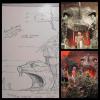|
STAR TREK PROPS & REPLICAS #04 |
Updated: October 07, 2025








































































How were artificial boulders and rocky outcroppings & edifices constructed for the sets of the original Star Trek episodes?
As a kid getting X-rayed sitting in front of an early model color television set, I was enthralled by the rocky planets that the
crew of the USS Enterprise visited.
As an adult I'm still coming to terms with the idea that these were sets and props, and those giant boulders and ( Some of ) the rocky outcroppings were constructed from ( Likely ) cheap and light weight materials of some sort.
Ladder to the Stars: Talos IV Surface Set Construction with Aluminum Foil This shot, digitized from a reference film owned by Matt Jefferies, shows the construction of the set used for the filming of the original 1964 pilot "The Cage." Visible are the rock outcropping and elevator components, a large piece of aluminum foil for surface treatment, the rocks which are being hoisted and
put in place, and a normal wooden step ladder, ten feet or so in height by the looks of it.
This set, while filmed beginning in November 1964, was being designed and constructed in August through October 1964, so 50 years
ago now. Also visible in this shot is the green tinged cyclorama background, the hue chosen to give a more alien feel to the planet surface where the illusion of the Columbia crash survivors and Vina ( And visiting Talosians ) would encounter the crew of the Enterprise as captained by Christopher Pike. But you know all that .....
It is known that the rocks were constructed by essentially layering a plaster foam material onto foil and then painting it. Here swaths of the aluminum foil can be seen that have not been coated yet. On second thoughts, these seem widely available bts stills from the filming of The Cage.
The boulders were generally spraypainted foam. I suspect the rock faces were made of the same material. Trying to find a quote for it... Here are two pieces being sold online. I've also seen references to them being made out of paper mache such as here. And, of course, sometimes the rocks were real.
But are these solid foam, or was there perhaps a wooden framework and chicken wire to support a skin of foam? I'm asking how they were constructed, not just what they were made of. Constructing those huge textured walls must have required some fabric or undulating mesh as well, perhaps plaster and cloth?
To a geologist, the foam boulders never look real. The overall forms are generally too spherical and the surfaces look draped over supports. In motion, they bounce too lightly and have too little effect on the soil and vegetation they hit. And usually there is
no attempt at stratification. However, as FuzzyBoots points out, sometimes the rocks are real.
|
 HOME
HOME
 About
About
 EMail Me
EMail Me TOP |
TOP |  PREVIOUS ITEM | NEXT ITEM
PREVIOUS ITEM | NEXT ITEM  ( 104 of 109 )
( 104 of 109 )








































































